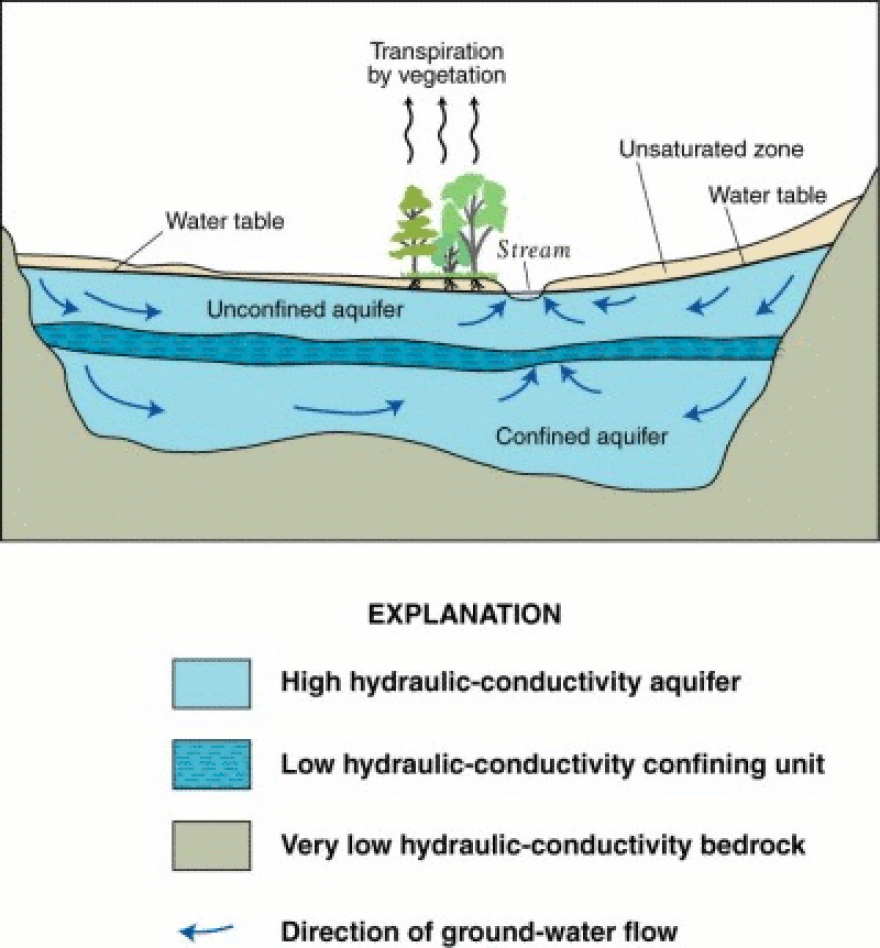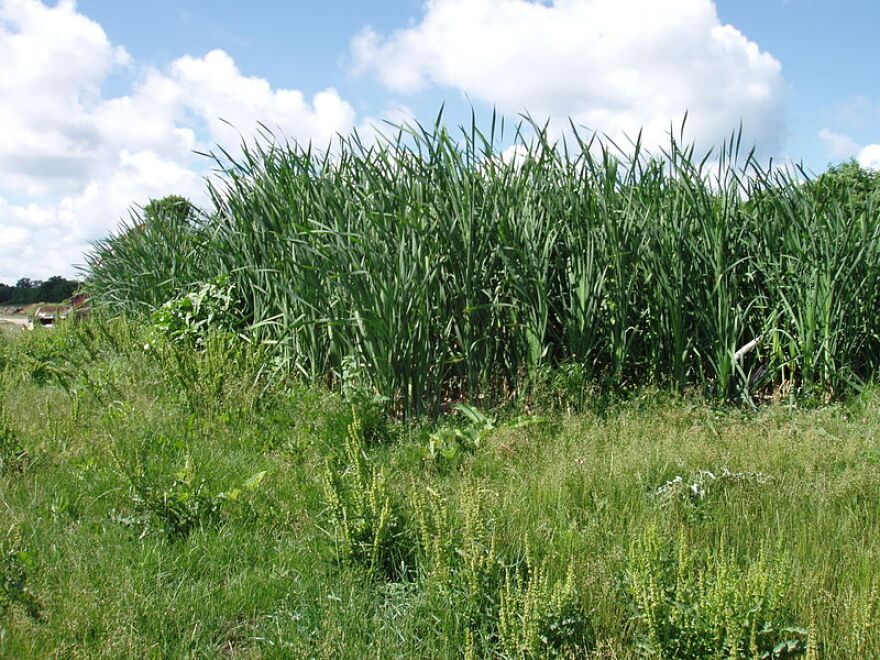As we explore the Gulf Coast more comprehensively than ever before, trying to understand better the complex relationships inherent in the restoration process, there's a lot to learn and keep track of.
In order to both understand and talk about coastal erosion, an expanded vocabulary is needed — one filled with brand-new terms whose definitions are integral to absorbing the problems and solutions Louisiana faces around water and land loss.
In our ongoing attempt to help explain the dynamic state of the local ecosystem, WWNO's Coastal Desk has created the "Coastal Glossary" where we will define the terms you, our audience, will need to know in order to talk about and discuss what is happening in New Orleans, and the Gulf Coast. We will present words like "diversion," "subsidence," "turbidity," and "bioswale," and bring in local experts to give readily understandable explanations. This glossary will continue to expand as our reporting continues.
Aquaculture: the cultivation of freshwater and saltwater populations under controlled conditions. Whereas commercial fishing is the harvesting of wild fish, akin to hunting and gathering, aquaculture is more akin to agriculture; it’s like farming. In Louisiana, we farm crawfish, catfish, alligators, this is all aquaculture.

Aquifer: An aquifer is underground water- it can be in an opening that is contained by impervious surfaces, like hard rocks underground. So there’s this water underground that’s taken hundreds, maybe thousands of years to flow and get there, so it’s really clean water. Most cities use these for drinking water, but New Orleans doesn’t since we don’t have such underground hard surfaces. Aquifers are very important to protect because pollutants from the top can infiltrate down, get into an aquifer, and really destroy high quality drinking water.

Barrier Islands: a result of an eroding delta process. As this delta erodes from both sides, the sediment gets redistributed and the heavier sediments form barriers along the coastal areas, and that’s how barrier islands are formed. Barrier islands play an enormous role in mitigating storm events for the water systems behind on the mainland side of the barrier island. Without barrier islands, our wetlands could not exist and would be destroyed by daily ocean waves and tides.
Bioswale: An open channel or ditch, that usually has gentle sides to it, and native plants planted along it. It conveys water, much like a pipe does, from one point to another. The great thing about a bioswale is that along the way, because there are native plants and engineered soils, pollutants are cleaned out of the water. A lot of the water is taken up and retained, so it never ends up in a pipe; what does end up in the pipes is cleaner water.

Brackish: the amount of salinity in the water. Brackish water is a very im[protant part of an estuary where many of the marine organisms come in and need the mixture of fresh and salt water.
Bycatch: What fishermen catch by mistake, what they don’t mean to catch, it could be sea turtles, dolphins, fish that are out of season, or fish that are just too small. Bycatch is usually discarded dead or dying. It can be a serious ecological problem when the bycatch species are at risk. There’s a lot of work being done to reduce bycatch through escape panels in nets, circle shaped hooks, and other modifications to fishing gear.

CWPPRA: (pronounced kwǐp-rŭh) stands for the Coastal Wetlands Planning, Protection and Restoration Act. It was enacted by federal legislation in 1990 to identify, prepare, and fund construction of coastal wetlands restoration projects. Since it began, 151 coastal restoration or protection projects have been authorized which have benefited over 110,000 acres in Louisiana.
Dead Zone: an occurrence, normally associated with a river system. In our case, the Mississippi river has all kinds of things in it that has to decompose. When anything decomposes, it takes oxygen for that to happen. So it takes oxygen out of the water and creates an oxygen zone situation where no animal can survive.

Diversion: A deliberate structure or outlet for river water to flow from the Mississippi River out into the wetlands. With the wetlands loss crisis, the intent of diversions has shifted more towards trying to deliver sediment and helping maintain or rebuild wetlands in today's coastal system.

Dredging: Here in Coastal Louisiana, dredging has two important meanings. First, dredging is scooping out bottom sediments, mostly to move them to other locations. This is a technique that’s often used to keep waterways navigable. It’s also a way to get sediment to use to build land as we fight our coastal land loss crisis. Dredging also means fishing for species from the bottom, like oysters, In either case, the dredge is the device that’s used to gather things up from the bottom of the water.
Estuary: a freshwater system that goes into the sea and that mixture of saltwater and freshwater is one of the highest productive areas as far as marine life is concerned. Many of the marine organisms that we love to eat and that are the basis of most fisheries require part of their life cycle to be inside of an estuary.

Fecal Coliform: a type of bacteria commonly found in human and animal feces. This bacteria can make its way into waterways when septic tanks are not functioning properly and discharge into bayous and ditches. The presence of fecal coliform bacteria in a water body indicates potentially high levels of dangerous pathogens. High levels of fecal coliform can make it unsafe to swim or fish in those areas.
Fisherie: Everything that’s involved in the capture of fish. The term is defined very broadly to include everything related to the business, the occupation, the industry, the boats, fishing gear, or the fish. Some of the most important fisheries here in Coastal Louisiana are shrimp and oysters, crabs and crawfish, and recreational fishing is also very important.
Flood Gate: Used to control the flow of water in a canal or bayou. It is usually a part of a larger levee system and is meant to help control rising waters associated with strong weather events and hurricane storm surges.

Invasive Species: plants, animals or pathogens that are non-native to an ecosystem and whose introduction causes damage. Invasive species can be very harmful to an ecosystem because they frequently have no natural predators and their populations can grow to unhealthy sizes very quickly. Examples of invasive species in south Louisiana include the apple snail, nutria and water hyacinth.

Mitigation: In the case of coastal restoration, mitigation means to mitigate damages to wetlands. This happens in a permitting process; if someone has proposed a project, like a road, and the road will negatively impact wetlands (cover them up or reduce their function,) mitigation forces the developers to make up that deficit. That means developers would rebuild or enhance some habitat elsewhere that would make up at least the amount of damage that their project is causing.


Rain Garden: A depression, or low area, like a bowl, in a piece of land. Water flows into it. There are plants planted there. Where the water sits, the plants take up pollutants, and the water. The water has a chance to sit there and infiltrate the ground. The great thing is that water never gets into the pipe system, never causes downstream flooding, and the water is cleaner.

Runoff: Rainfall that hits ground where it can’t infiltrate, as it hits an impervious surface, such as concrete, asphalt, or a rooftops. That water that runs off all collects and goes downstream. This causes flooding in areas, because you have way too much water running off and not going back into the ground.
Saltwater Intrusion: the movement of saline water into freshwater systems, which can lead to the distruction of certain ecosystems. Contributors to saltwater intrusion include bayous, navigation canals, and drainage ditches, which provide conduits for saltwater to move inland. Saltwater intrusion can also be worsened by extreme events like hurricane storm surges. Sea level rise also contributes to saltwater intrusion.
Sediment: a naturally occurring material that is broken down by processes of weathering and erosion, and is subsequently transported by the action of wind, water, or ice, and/or by the force of gravity acting on the particles. In coastal Louisiana, the clays and sands and materials coming out of the river system settle out on the bottom and form the basis of the land we live on today.
Subsidence: The land surface moving downwards, closer to the center of the earth. Areas that were once high enough to support vegetation, like in a marsh, drop a foot or two lower over time. This causes land that never flooded to start flooding, and those plants can no longer survive. Subsidence contributes to our wetlands loss crisis but is also challenges the coastal restoration because if we're going to rebuild wetlands it has to overcome subsidence that will occur in the future.
Sustainability: A balance between the resources that are used by humans, and how humans pay back to maintain that system. What is taken from the natural environment is given back in a way that it maintains and perpetuates the natural system indefinitely for future generations.
Turbidity: Something that we perceive and measure in water. It often represents sediment (clay, sand); the material is suspended in the water, often because of water movement. As we rebuild our coast and if we divert river water into our wetlands, we want high turbidity. Rich sediment in the river water replenishes our wetlands more effectively and efficiently.
Watershed: An area in which all the rainfall that hits that ground area, and all the waters and bayous and streams in it, flow to one low point. That low point flows out to another watershed or water body. What happens to the pollutants or whether there are pollutants in that water has a lot to do with land uses around it. So the way we protect the water that ends up at that low spot, for instance in Lake Pontchartrain basin, is important.
Support for WWNO's Coastal Desk comes from the Walton Family Foundation, the Greater New Orleans Foundation, and the Kabacoff Family Foundation.



